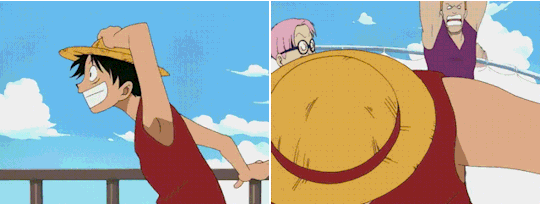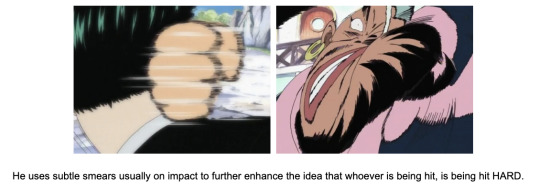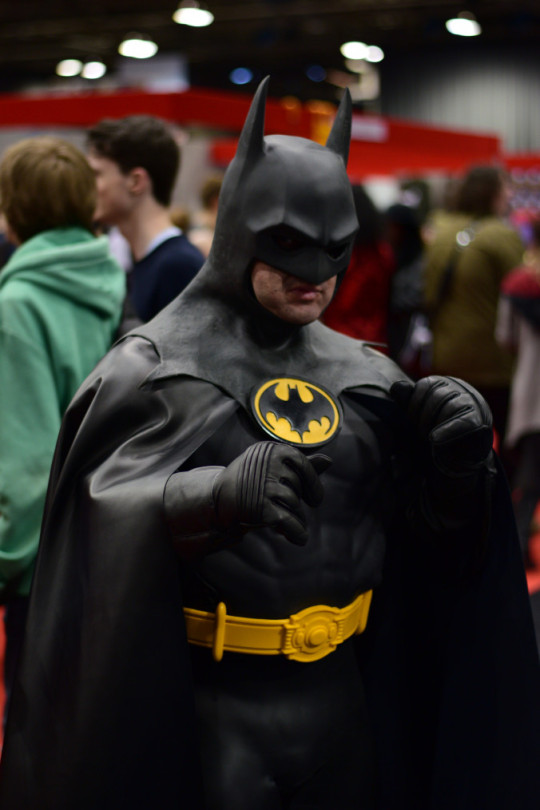#but for higher stage Digimon it can be hard to tell like. what they even are
Text

Got Lordknightmon X :) me if I had the X Antibody
#idk how easy it is to tell just from the pixel art lol#the pixel art is very charming and iconic obviously#but for higher stage Digimon it can be hard to tell like. what they even are#i had to double check after Rafflesimon evolved#I’ve fallen in love with the Digimon X over the past ~week#and I’m really frustrated about the whole situation with the version 2#I’ve ONLY been able to find either the English version on like. Australian target which idk if they’d even ship over here#or the Japanese version for like $70+ apiece#like I don’t care if the rosters were switched I just want a way to get them easier and at a reasonable price
5 notes
·
View notes
Text
One Piece Animation Thesis: East Blue

If you would prefer to follow via the master Google Doc, [HERE] is the link! This will be updated as we go through the arcs and is currently planned to be updated weekly!
------------------------------------------------------------------------------
Whew hey everyone!
So this is the beginning of a project that I have had in the back of my mind for quite some time and finally decided to start working on. A quick rundown of what this actually is, it’s a somewhat showcase of the animation found within the main One Piece anime (so, no movies/specials/filler arcs between canon arcs etc. although that may be something I will attempt to tackle one day if this does well). This will also include some insight into the anime industry and essentially give some insight on behind the scenes and why certain decisions are made as well as giving names of the hard working animators to their respective scenes. Hopefully this whole thing will continue to give a bit of insight into the One Piece anime as I believe that it is greatly under appreciated and while criticisms of it are valid, there definitely needs to be more of an understanding as to why the anime is the way it is.
This will be a long journey ahead so please bear with me! Let’s get started!
The One Piece anime, including movies and specials, is animated by Toei Animation, and they are responsible for many other famous animated properties and adaptations, including Digimon, Dragon Ball/Z/GT/Super, Sailor Moon, Toriko, Gegege no Kitaro among many others. They animate many different series and have a big load to take on. This is something that will be touched on later, because it greatly affects the anime in later years. But for now, I’ll be going through the arcs, starting with the East Blue saga.
The East Blue saga is made up of episodes 1-53 (including some filler) and consists of quite actually not that many noteworthy animated scenes, even though it covers many arcs (Shells Town, Orange Town, Syrup Village, Baratie, Arlong Park, LogueTown). Animation throughout this portion of the anime was quite limited, using minimal movement and taking appropriate shortcuts where necessary. Scenes are also quite hard to tell exactly who animated what due to the style consistency. There are a few noteworthy scenes though, but first I would like to introduce the rough structure of how the anime is made.
An important part in animation is someone who is the character designer, someone who essentially designs the characters and in this case, attempts to replicate Oda’s style for it to be easily animated. During this part of the anime, the character designer is Noboru Kizumi who would continue to be the character designer for the anime for the next 10 or so years. These are the some of the sheets he made for the main characters:

This is something I’ll continue to showcase as we continue to go through each of the arcs, showcasing the strawhats as they pop up in the story. When the time comes, we will also compare the changes of style and why things have changed. But for now, I’ll just present the first designs.
One Piece at this stage was very cartoony and had quite a different style, especially compared to a lot of the current anime/manga at the time and it still continues to have a distinctive style to this day. Following these sheets allows for a good sense of continuity, which is very important with anime. If anyone out there attempts to draw something without looking at a reference, it’s not going to look quite as well as we want it to. So in using a reference, we can have a better grasp as to how the character looks from certain angles, heights compared to other characters, facial expressions and more.
In order to keep these characters looking somewhat similar so as to not disrupt the viewer’s experience by seeing jarring styles, someone works as a Chief Animation Director. They aim to ensure that characters remain consistent throughout the episode, and that they are on model. So, how is this achieved? Well, we’ll have a look at the process on how something is conceptualised and then put to screen.
Initially, a script is conducted. Going through the manga, people take what is deemed necessary material and put it into script format. It is important to note that as the anime and manga continue to go on for years, the gap between the anime and manga release shortened significantly, resulting in pacing issues. Keep this in mind for later as this is something I plan to touch on. Then a storyboard is created, having very rough lines in order to convey what is to be created. Here is an example:

A good storyboard can make or break an episode, as it dictates angles, how long scenes linger on screen, etc. Once the storyboard has been decided on, the animating can begin. Scenes are appointed to animators, where they create something called Genga. This is done on paper, similar to how it’s done in other parts of the world. Here are some examples of older Genga:

Even though times have changed and anime has become digital, with some animators now exclusively animating digitally, the anime industry still uses Genga, using paper and pencil to create their scenes. Here are some examples of newer Genga:

Once the Genga has been created, the Chief Animation Director will go in and correct what is necessary to ensure that the style remains consistent. Others may also help participate in this process, such as an Animation Supervisor. Here is an example of a Genga being corrected to ensure that it remains consistent in style:

In doing something like this, some animators can animate great action and keep their lines rough to save time, and an Animation Supervisor can clean it up and make it look good.
After this has been completed, the Genga is then made into what is called Animation Cels. This is not exclusive to Japan, as for decades this is a process that has been used. This is a transparent sheet that had the lines and colours painted on, and is then photographed over painted backgrounds. Yeah...A long and dubious process indeed. This is not common place anymore due to how time consuming it is, and with the rise of digital, creating colours, effects, filters and backgrounds are much faster and easier to accomplish. Here are some examples of One Piece animation cels:

I would have much preferred to share cels directly from the anime itself and not the movies but they are quite difficult to come across and have more than likely been sold off from Toei long ago. But they will suffice, as it gives a good idea as to what they look like.
But voila! Animation has been created! All that’s left is music, sound effects and voice over and you’ve got yourself an anime. Wonderful. Easy right? Yeah, not exactly. All of this takes time and patience. And this is something that needs to be remembered. Time. A very important keyword in the animation industry and a lot more important than the word budget that likes to get thrown around. Due to One Piece being a long running weekly series, the animators have a lot less time than, say, My Hero Academia or Demon Slayer, two very prominent seasonal anime. These series do not have more money shoved into them, more budget, than One Piece that results in higher quality and consistent animation, a problem the One Piece anime definitely faces further down the road. Here’s an example:
Michelangelo is one of the most famous artists of all time, due to his remarkable attention to detail in his works present in the High Renaissance period. One of his most famous works is the Statue of David, an incredible piece of work that was worked on for 3 years. However, if you were to tell him to replicate it but say, give him a month, he’s not going to get anywhere near the same results as the piece where he spent 3 years on. It would be quite rough around the edges, and quite rushed. No matter how much money you throw his way, he still won’t be able to get anywhere close to those results. And this is the same with any artist, including animation. This is a big misconception in the anime community, and that is that as long as you throw money at people, they’re going to end up creating incredible works, regardless of the poor time management. That is just not how it works.
This does seem like quite a ramble, and it’s already quite long prior to even reaching the main aspect of this whole project, in which I showcase animators, but this is important background information that needs to be understood prior to delving in. With that very long introduction, let’s now get to showcasing animators!
Some of the animators that were present on many early One Piece episodes include:
Kazuya Hisada, Masahiro Shimanuki, Naoki Tate, Jin Inaba, Tadayoshi Yamamuro. Please note, there are many others involved animating wise, but these are some key names, and ones that will develop and evolve as the years go on.
Kazuya Hisada is someone who will pop up later and fulfil a more important role in the series, but in the early days he created some great scenes with some snappy timing, while using lines to help convey impact. He is found throughout early One Piece, however due to the limited animation and consistent style thanks to Noboru Kizumi, he can be difficult like most during this era to spot.


Hideaki Maniwa is more prominent in his animation, being more pronounced due to his camera movement on his characters. He uses subtle smears usually on impact to further enhance the idea that whoever is being hit, is being hit HARD. He also created the most animated piece of early One Piece in episode 23 where he creates seemingly natural movement of the background of the ship and water, making the sea feel powerful and heavy.



So what have we learnt so far.
Well, there is a lot of hard work that goes into the production of an anime series, and that is no different with One Piece. Early episodes for the most part had not too many interesting scenes animation wise, and the animators essentially got the work done in order to produce and release the series week to week. It will continue to be a bit of a slow start, with arcs like Alabasta and SkyPiea being similar in the regard of not many noteworthy scenes however, we can begin to see the cracks of emerging stars and evolving styles that will later become staples within the series.
This is it to the first of what is hopefully a long and engaging project! So far it has been quite a read and very lengthy and I apologise for that. Hopefully from here on out we should be able to successfully get through more animators and styles become more distinct and animation continues to evolve. Next up I intend to cover Alabasta.
------------------------------------------------------------------------------
A massive thank you to everyone who has participated and uploaded at Sakugabooru! Without it, I would not have been able to make nearly as much as I have without all the hard work in identifying and tagging animators’ work! Most of the footage used to showcase these animators has come from there! I simply just turned the videos into gifs for an easier showcase.
I would also like to issue a big thank you to Animators Corner! The staff listing really helped me in determining who worked on what episode to identify animators and their works!
#one piece#anime#opgraphics#gif#if you could please share this!#would love for this to be spread thank you!#op animation thesis
229 notes
·
View notes
Text

On stage voice actor Troy Baker talks about how we all have our nerd, from those of us who love comics or Star Wars or movies to the people who are obsessed with engines or skiing or racing or anything else. Everyone, he says, is a nerd in their own way because being a nerd simply means being really obsessed with something, spending more and more time learning about it and enjoying it. And that’s the thing, isn’t it? Every person has that one thing they really love. Every person is a nerd. The only difference, muses Troy Baker, is that those of us at comic-con know we’re nerds and have embraced it.
The MCM show in Glasgow is the perfect example of this theory. It’s filled with people who passionately love comics, anime, movies, games and a bunch of other things, and all of them know they are nerds. They accept it. They are ahead of the curve. And so many of them are like me, not just in the sense that they share my passions but also in how they grew up in a time where reading comics or loving videogames or anything that wasn’t “normal” was viewed as something bad, a time when the label of nerd carried a lot of horrible stigmas with it. We were the outsiders, the forgotten, the picked on, just because of things we liked. But look how things have changed. Because of stuff like the Marvel Cinematic Universe people who had never read a comic are talking about Captain America or the Guardians of the Galaxy or Daredevil. There are still things that are generally seen with disdain, like anime, but by and large being a geek is…weirdly cool? When you live in a world where people are happily going to the cinema to watch the Suicide Squad being a geek almost means less than it once did, and yet at the same time it means so much more now.
Being in a crowd at comic-con is a unique experience. The sheer amount of people coupled with the wide variety of costumes on display makes it both claustrophobic and exciting. I don’t think you can adequately do the experience justice when attempting to tell people why it’s worth attending a convention, especially if you happen to mention the often insanely long queues or the fact that wanting to look at some merchandise can become an epic quest where you have to battle a torrent of people jostling around. And don’t dare mention the absurdly inflated prices of food. Bloody hell. But that’s like saying you shouldn’t attend a concert because the hot dogs are pricey, it’s as hot as the sun and you keep getting bumped by strangers.

So why the hell should anyone go? Simple; the people. Sure, the guests are cool and there’s some sweet loot to be picked up and maybe some awesome comics to discover, but you can get all that loot and comics on the Internet and watch guest panels on Youtube where you at least have the option of lounging around in your boxers while munching a bag of Jelly Babies, something which I discovered MCM frowns upon in their live panels. No, you should come because of the people. An entire building full of fine folk who share your passions and nerdery, who are willing to spend time and money creating elaborate costumes for themselves and others to enjoy. Stop just about anyone and you can easily strike up a conversation. For someone like me who has social anxiety and kind of sucks at being a human being, in general, getting trapped in massive crowds sounds like a stupid idea, but in truth it’s one of the best places to push past anxiety because these wonderful, wonderful people are the least judgemental folk around. How could they be, when they’re dressed up as the Joker or as a Digimon character? It’s kind of hard to poke fun at someone for being anxious when you’re dressed up as Sailor Moon, after all. No, despite the crowds comic-con is a prime place to say, “today I’m going to push myself by trying to meet new people” and at the end of the day if it goes poorly you’ll probably never seen any of them ever again.
Of course, if you are after that sweet, sweet loot and view people as little more than walking nuisances then there’s plenty of things to get your hands on. This can vary from convention to convention, but there is usually something awesome to be found if you have a rake around, from commissioned artwork from a talented pool of artists to some sweet indie comics or custom-made props. This year at Glasgow I had to admit that I was a touch disappointed as comics and comic-related merchandise felt like it had taken a back seat to anime, but that’s a personal thing and comic-cons haven’t actually been about comics in quite a long time. They’re now a celebration of comics, games, movies, TV shows and yes, anime.
Events like this tend to attract guests who come to speak to audiences, as well as sign merchandise and get photos taken with fans provided they can pay. Troy Baker was the highlight guest for me, his voice, along with Nolan North, arguably being the dominant force in videogame voice acting, He took to the stage to deliver a near hour-long panel where he managed to answer just over six questions due to the fact that every answer would detour into an entertaining and thoughtful tangent. He was funny, sincere, informative and held the audience in the palm of his hand. Sadly my own interview with him was cancelled as all his interviews were shifted to the Sunday at the very last minute, but I’m attempting to talk to him via Email instead so with any luck a Q&A with the man himself will happen. Regardless, despite his own admittance that he found doing panels scary it was also clear that he was a natural at it.

But other guests lit up the event, too, such as Manu Bennet who played Crixus in Spartacus and is currently rocking it as Deathstroke over on the Arrow TV show. There was also and Bryce Papenbrook and Trina Nishimura from Attack on Titan whose panel had the crowd nearly constantly laughing as they regaled them with behind the scenes tales and answered questions.
Still, with absolutely no disrespect intended to any of the guests who came to Glasgow’s event it is fair to say that the London show continues to attract higher-profile stars. Hopefully, as the Glasgow comic-con continues to get larger MCM might be able to persuade some of those people to come up to bonny Scotland to entertain the legions of fans who reside here.
Both the Saturday and Sunday were rounded off with the official cosplay masquerade where those in costume could come up on stage to display their efforts, while judges carefully eyed them up to pick a winner. As much fun as it is discovering amazing cosplays while walking around it’s arguably even better to see them up on stage where coloured lighting makes them look even better. Entrants can also choose backing music, and will either have a variety of poses or even a whole act. One person came out as Captain Phasma, for example, before busting out some fancy dance moves. It’s the perfect way to end the convention.
It’s amazing to think that despite how many people attend the Glasgow ‘Con is still quite young, and the organizers are still fine-tuning everything. This year guest panels and the masquerade were held in a different part of the SECC building, freeing up space in the two main halls which, along with some general restructuring of the layout, gave people a lot more room to move around compared to two years ago when there were severe cases of traffic jams. The extra space wasn’t enough to cope with the onslaught of visitors, though, as legions of fans poured in to celebrate their geekdom. The paths may have been wider, but at the ‘Cons Saturday peak it was still hard to push through the throngs. If you’re taking little children it’s fair to say that while people will do their best to avoid bumping into them there’s inevitably going to be accidents.
So, if you have an interest in comics, anime, cosplaying or a bunch of other geeky things then is it worth going to a comic-con? Yup. The crowds may mean it’s not really your cup of tea, it certainly can be exhausting, but it’s worth going at least once just for the experience of being amidst thousands of passionate people who share your love of everything nerdy and awesome.
Before we wrap this up with a bunch of pictures, though, here’s some general advice for adding comic-con or any other similar convention.
– Start planning early. When it comes to travel costs and hotel rooms booking early often means getting them cheaper, and that means you’ll have more cash to spend on stuff at the convention! In short, if you want to attend a convention the earlier you decide to do it the better.
– Check the schedule. Convention’s will typically publish a schedule well in advance of the event that will tell you when certain guests will be speaking. Read it, pick what you don’t want to miss and then consider setting some alarms on your phone so that you don’t get carried away and completely miss seeing your favourite guest panel.
– Pack light. Pack smart. This one is obvious, but try to pack light. It’s tempting to take everything, especially if you’re like me and own a pile of camera gear, but you’re going to be walking all day and the crowds don’t mix well with chunky rucksacks. Take what you need.
– Take snacks and drinks. You’ll find plenty of food at conventions which makes it tempting to save some bag room by just grabbing stuff while you’re there, but frankly the price of food and drink at these events is absurd. Now, I generally champion supporting businesses where possible, but the huge inflation of prices makes eating at a convention very, very expensive. Take a few snacks with you, and pack some water to sip on the way round because the crowds tend to make the whole place kind of hot.
– But do check if bag searches will be in operation. To put it bluntly bag searches are about as effective as airport searches when it comes to catching potential threats, which is to say they aren’t. But still, buildings hosting conventions will often employ these to help people feel safer, which also means you might get any drinks and other things confiscated on the way in. Chec before you attend to see if these searches will be happening. I got caught out no long ago when I went to 4TG and bag searching was not stated anywhere on the event site. They took my bottle of Coke away. Damn you random security guard. Damn you.
– Take out money beforehand. Many sellers at a convention will take card payment these days, but many won’t and guests doing signings will typically want cash. While there are often ATMs at a convention the queues tend to be massive, so visit a bank or ATM before the event and stock up on pennies.
– Budget. Another good reason to take out some cash before the event is that it makes it easier to limit your spending. Cards are great, but let’s face it, it’s pretty easy to get carried away with spending. By picking a limit and then putting that amount of money in your bag or wallet or pocket it’s much easier to keep your spending in check as you can visibly see your funds dwindling.
– Shop around. It’s so tempting when you see something to immediately whip our your money and start flinging it at the seller, but show some patience and have a look around. Provided the item you’ve seen isn’t one of a kind or of a very limited stock it’ll still be there later on, and that gives you time to see if anybody else at the convention is selling it for a better price. You could also consider checking online. Now, I advocate buying from the sellers at the conventions where possible, even if the prices there are a bit higher than you’d pay online, but there are times when sellers massively mark up their prices so it might be an idea to head onto the Internet and see how much cheaper it might be. If the price difference is significant, then maybe you should wait until you get home to order it. If it’s not too bad, go ahead and support a local seller.
– Buy later. Again, it’s tempting to just grab stuff as soon as you see it, but keep in mind that you might still have hours and hours of convention time left where you have to carry that item with you. That’s extra weight while you walk. Provided it’s not a limited item or one of a kind consider going back to buy it later in the day. If you are worried about it disappearing ask the seller if they’d consider keeping it back for you. I’ve done this a few times when I’ve been buying unique things, sometimes agreeing to pay half the price as a deposit or even the full amount upfront. Many sellers are happy to do this for you. Try to get something written, though, so when you come back later you’ve got some physical proof just in case.
– Haggle. Many sellers are willing to haggle price with you if you try, but this is especially true of the various people selling their own comics. They’re quite willing to do you a deal for multiple issues in most cases, so it does no harm to haggle a little.
– Take photos, but ask first. Taking photos is pretty much expected at a convention, especially since there are so many awesome costumes on display, but the general rule, as you’ll see written on most convention’s guidelines, is to ask permission before taking a picture. For cosplayers this also gives them the chance to get into a pose. Of course general shots of crowds and queues are the exception since you can’t be expected to ask for permission from hundreds, if not thousands, of people.
– Battery power! Another obvious one, but make sure any tech you’re taking is fully charged. If you’re going to be using a phone to take pictures then consider investing in a power bank to take with you so that you don’t run out of juice. This is especially important if you need to be able to call a taxi or something after the event, although generally the building’s reception is happy to help.
– Brush up on the rules. If you intend on going in costume make sure you thoroughly read the rules and regulations surrounding prop weapons, as many things simply aren’t allowed.
– Just have fun, yeah?
–
Nerding It Up At MCM Glasgow Comic-Con 2017 (Plus A Guide To ‘Conning) On stage voice actor Troy Baker talks about how we all have our nerd, from those of us who love comics or Star Wars or movies to the people who are obsessed with engines or skiing or racing or anything else.
0 notes